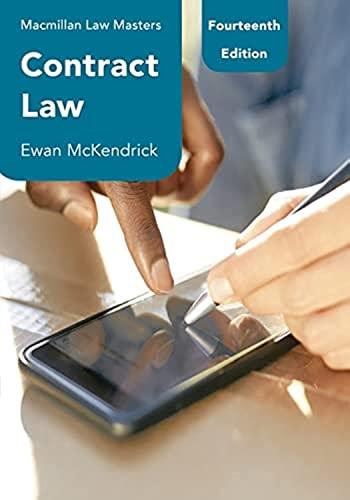Question
I have selected an opinion article from the New York Times, published on February 07,07,2024, and called The Supreme Court Should Get Out of the
I have selected an opinion article from the New York Times, published on February 07,07,2024, and called "The Supreme Court Should Get Out of the Insurrected Business." by Akhil Reed Amar.
Conclusion:The article is about how the Supreme Court should apply an original interpretation to Section 3 of the 14th Amendment in the Trump case. It suggests that a 50-state solution, allowing each state to use Section 3 according to its policies, respects federalism and preserves constitutional principles while addressing the January 6, 2021, Capitol storming case, which may prevent Donald Trump from running for president in Colorado.
Premise 1:Section 3 of the 14th Amendment restricts individuals who engage in insurrection from having an office, which differs from Trump's lawyers' opinions.
Sub-premise: the purpose of the 14th Amendment was to protect our democratic system from anyone trying to harm it.
Premise 2:Supporting a 50-state solution respects federalism by allowing each state to apply Section 3 according to its election process.
Sub-premise:The 50-state solution respects federalism by letting states decide their election rules, showing that each state has its own needs and preferences.
The statement seems credible because it relies on historical evidence and gives a fair approach. By considering the original purpose of the 14th Amendment and presenting a 50-state solution, it respects both the Constitution and the diversity of states. While it offers a reasonable perspective, it's important to consider different viewpoints to understand the issue entirely.
Identify whether the argument is inductive or deductive and briefly explain your reasoning
based on the summary above please answer the following ?
- Identify unstated premises (warrants) that connect premises to conclusions and critically assess whether those unstated premises are reasonable and well-supported. Explain your reasoning using credible sources. This is the big one - the ability to identify the underlying reasoning that connects premises to conclusions is in large part what makes for effective critical reasoning.
- Provide your own assessment of the argument's credibility. Do you agree with your classmate's assessment, or do you have a different take? What might account for that agreement or disagreement? Is it possible that some cognitive bias might be influencing one or both of you? What aspects of the argument make the argument more and/or less credible? Briefly explain your reasoning.
- Provide your own assessment of the argument's credibility. Do you agree with your classmate's assessment, or do you have a different take? What might account for that agreement or disagreement? Is it possible that some cognitive bias might be influencing one or both of you? What aspects of the argument make the argument more and/or less credible? Briefly explain your reasoning.
Step by Step Solution
There are 3 Steps involved in it
Step: 1

Get Instant Access to Expert-Tailored Solutions
See step-by-step solutions with expert insights and AI powered tools for academic success
Step: 2

Step: 3

Ace Your Homework with AI
Get the answers you need in no time with our AI-driven, step-by-step assistance
Get Started


